One-Pot Hydrothermal Synthesis of La-Doped ZnIn2S4 Microspheres with Improved Visible-Light Photocatalytic Performance
Abstract
1. Introduction
2. Experimental Details
2.1. Materials
2.2. Synthesis of Pure ZnIn2S4 (ZIS) and La-Doped ZIS
2.3. Characterization
2.4. Photoelectrochemical Measurements
2.5. Photocatalytic Experiments
3. Results and Discussion
3.1. Phase Structure and Composition
3.2. Morphology and Brunauer-Emmett-Teller (BET) Analysis
3.3. Optical Characterization
3.4. Photocatalytic Activities
3.5. Possible Photocatalytic Mechanism
4. Conclusions
Supplementary Materials
Author Contributions
Funding
Acknowledgments
Conflicts of Interest
References
- Sharma, V.K.; Feng, M. Water depollution using metal-organic frameworks-catalyzed advanced oxidation processes: A review. J. Hazard. Mater. 2019, 372, 3–16. [Google Scholar] [CrossRef]
- Schwarzenbach, R.P.; Escher, B.I.; Fenner, K.; Hofstetter, T.B.; Johnson, C.A.; Von Gunten, U.; Wehrli, B. The challenge of micropollutants in aquatic systems. Science 2006, 313, 1072–1077. [Google Scholar] [CrossRef]
- Tang, J.; Zou, Z.; Ye, J. Efficient photocatalytic decomposition of organic contaminants over CaBi2O4 under visible-light irradiation. Angew. Chem. Int. Ed. 2004, 43, 4463–4466. [Google Scholar] [CrossRef]
- Jia, T.; Wang, W.; Long, F.; Fu, Z.; Wang, H.; Zhang, Q. Synthesis, characterization, and photocatalytic activity of Zn-doped SnO2 hierarchical architectures assembled by nanocones. J. Phys. Chem. C 2009, 113, 9071–9077. [Google Scholar] [CrossRef]
- Barndõk, H.; Hermosilla, D.; Han, C.; Dionysiou, D.D.; Negro, C.; Blanco, Á. Degradation of 1,4-dioxane from industrial wastewater by solar photocatalysis using immobilized NF-TiO2 composite with monodisperse TiO2 nanoparticles. Appl. Catal. B Environ. 2016, 180, 44–52. [Google Scholar] [CrossRef]
- Ma, T.; Qiao, S. Acid–base bifunctional periodic mesoporous metal phosphonates for synergistically and heterogeneously catalyzing CO2 conversion. ACS Catal. 2014, 4, 3847–3855. [Google Scholar] [CrossRef]
- Chen, Z.; Li, D.; Zhang, W.; Shao, Y.; Chen, T.; Sun, M.; Fu, X. Photocatalytic degradation of dyes by ZnIn2S4 microspheres under visible light irradiation. J. Phys. Chem. C 2009, 113, 4433–4440. [Google Scholar] [CrossRef]
- Shi, L.; Yin, P.; Dai, Y. Synthesis and photocatalytic performance of ZnIn2S4 nanotubes and nanowires. Langmuir 2013, 29, 12818–12822. [Google Scholar] [CrossRef]
- Chen, Y.; Huang, R.; Chen, D.; Wang, Y.; Liu, W.; Li, X.; Li, Z. Exploring the different photocatalytic performance for dye degradations over hexagonal ZnIn2S4 microspheres and cubic ZnIn2S4 nanoparticles. ACS Appl. Mater. Interfaces 2012, 4, 2273–2279. [Google Scholar] [CrossRef]
- Liu, T.; Wang, L.; Lu, X.; Fan, J.; Cai, X.; Gao, B.; Miao, R.; Wang, J.; Lv, Y. Comparative study of the photocatalytic performance for the degradation of different dyes by ZnIn2S4: Adsorption, active species, and pathways. RSC Adv. 2017, 7, 12292–12300. [Google Scholar] [CrossRef]
- Adhikari, S.; Charanpahari, A.V.; Madras, G. Solar-light-driven improved photocatalytic performance of hierarchical ZnIn2S4 architectures. ACS Omega 2017, 2, 6926–6938. [Google Scholar] [CrossRef]
- Liao, C.; Li, J.; Zhang, Y.; Qu, Y.; Jiang, P.; Cong, R.; Yang, T. Visible light driven photocatalytic H2 generation property of trigonal ZnIn2S4 prepared by high temperature solid state reaction. Mater. Lett. 2019, 248, 52–54. [Google Scholar] [CrossRef]
- Shang, L.; Zhou, C.; Bian, T.; Yu, H.; Wu, L.-Z.; Tung, C.-H.; Zhang, T. Facile synthesis of hierarchical ZnIn2S4 submicrospheres composed of ultrathin mesoporous nanosheets as a highly efficient visible-light-driven photocatalyst for H2 production. J. Mater. Chem. A 2013, 1, 4552–4558. [Google Scholar] [CrossRef]
- Chen, Y.; He, J.; Li, J.; Mao, M.; Yan, Z.; Wang, W.; Wang, J. Hydrilla derived ZnIn2S4 photocatalyst with hexagonal-cubic phase junctions: A bio-inspired approach for H2 evolution. Catal. Commun. 2016, 87, 1–5. [Google Scholar] [CrossRef]
- Pan, X.; Shang, C.; Wang, X.; Jin, M.; Zhang, Y.; Zhang, Z.; Wang, X.; Zhou, G. Enhanced photocatalytic H2 evolution over ZnIn2S4 flower-like microspheres doped with black phosphorus quantum dots. Nanomaterials 2019, 9, 1266. [Google Scholar] [CrossRef] [PubMed]
- Xiong, M.; Chai, B.; Yan, J.; Fan, G.; Song, G. Few-layer WS2 decorating ZnIn2S4 with markedly promoted charge separation and photocatalytic H2 evolution activity. Appl. Surf. Sci. 2020, 514, 145965. [Google Scholar] [CrossRef]
- Ye, L.; Wen, Z. ZnIn2S4 nanosheets decorating WO3 nanorods core-shell hybrids for boosting visible-light photocatalysis hydrogen generation. Int. J. Hydrogen Energy 2019, 44, 3751–3759. [Google Scholar] [CrossRef]
- Yang, C.; Li, Q.; Xia, Y.; Lv, K.; Li, M. Enhanced visible-light photocatalytic CO2 reduction performance of Znln2S4 microspheres by using CeO2 as cocatalyst. Appl. Surf. Sci. 2019, 464, 388–395. [Google Scholar] [CrossRef]
- Zhua, K.; Yanga, J.O.-; Zenga, Q.; Mengb, S.; Tenga, W.; Songa, Y.; Tanga, S.; Cui, Y. Fabrication of hierarchical ZnIn2S4 @ CNO nanosheets for photocatalytic hydrogen production and CO2 photoreduction. Chin. J. Catal. 2020, 41, 454–463. [Google Scholar] [CrossRef]
- Yuan, D.; Sun, M.; Tang, S.; Zhang, Y.; Wang, Z.; Qi, J.; Rao, Y.; Zhang, Q. All-solid-state BiVO4/ZnIn2S4 Z-scheme composite with efficient charge separations for improved visible light photocatalytic organics degradation. Chin. Chem. Lett. 2020, 31, 547–550. [Google Scholar] [CrossRef]
- Uddin, A.; Muhmood, T.; Guo, Z.; Gu, J.; Chen, H.; Jiang, F. Hydrothermal synthesis of 3D/2D heterojunctions of ZnIn2S4/oxygen doped g-C3N4 nanosheet for visible light driven photocatalysis of 2,4-dichlorophenoxyacetic acid degradation. J. Alloys. Compd. 2020, 845, 156206. [Google Scholar] [CrossRef]
- Xu, L.; Deng, X.; Li, Z. Photocatalytic splitting of thiols to produce disulfides and hydrogen over PtS/ZnIn2S4 nanocomposites under visible light. Appl. Catal. B Environ. 2018, 234, 50–55. [Google Scholar] [CrossRef]
- Shen, S.; Zhao, L.; Guan, X.; Zhang, N. Improving visible-light photocatalytic activity for hydrogen evolution over ZnIn2S4: A case study of alkaline-earth metal doping. J. Phys. Chem. Solids 2012, 73, 79–83. [Google Scholar] [CrossRef]
- Feng, C.; Yang, X.; Sun, Z.; Xue, J.; Sun, L.; Wang, J.; He, Z.; Yu, J. Dual interfacial synergism in Au-Pd/ZnIn2S4 for promoting photocatalytic selective oxidation of aromatic alcohol. Appl. Surf. Sci. 2020, 501, 144018. [Google Scholar] [CrossRef]
- Ana, H.; Li, M.; Liu, R.; Gao, Z.; Yin, Z. Design of AgxAu1−x alloy/ZnIn2S4 system with tunable spectral response and Schottky barrier height for visible-light-driven hydrogen evolution. Chem. Eng. J. 2020, 382, 122953. [Google Scholar] [CrossRef]
- Mandal, S.; Adhikari, S.; Pu, S.; Hui, M.; Kim, D.-H. Constructing gold-sensitized ZnIn2S4 microarchitectures for efficient visible light-driven photochemical oxidation and sensing of micropollutants. Appl. Surf. Sci. 2019, 498, 143840. [Google Scholar] [CrossRef]
- Wang, B.; Deng, Z.; Fu, X.; Xu, C.; Li, Z. Photodeposition of Pd nanoparticles on ZnIn2S4 for efficient alkylation of amines and ketones’ α-H with alcohols under visible light. Appl. Catal. B Environ. 2018, 237, 970–975. [Google Scholar] [CrossRef]
- Zhu, T.; Ye, X.; Zhang, Q.; Hui, Z.; Wang, X.; Chen, S. Efficient utilization of photogenerated electrons and holes for photocatalytic redox reactions using visible light-driven Au/ZnIn2S4 hybrid. J. Hazard. Mater. 2019, 367, 277–285. [Google Scholar] [CrossRef]
- Shen, S.; Chen, J.; Wang, X.; Zhao, L.; Guo, L. Microwave-assisted hydrothermal synthesis of transition-metal doped ZnIn2S4 and its photocatalytic activity for hydrogen evolution under visible light. J. Power Sources 2011, 196, 10112–10119. [Google Scholar] [CrossRef]
- Xing, F.; Liu, Q.; Huang, C. Mo-doped ZnIn2S4 flower-like hollow microspheres for improved visible light-driven hydrogen evolution. Sol. RRL 2019, 4, 1900483. [Google Scholar] [CrossRef]
- Tan, C.; Zhu, G.Q.; Hojamberdiev, M.; Lokesh, K.S.; Luo, X.; Luo, J.; Zhou, J.; Liu, P. Adsorption and enhanced photocatalytic activity of the {0001} faceted Sm-doped ZnIn2S4 microspheres. J. Hazard. Mater. 2014, 278, 572–583. [Google Scholar] [CrossRef]
- Gao, B.; Liu, L.; Liu, J.; Yang, F. Photocatalytic degradation of 2,4,6-tribromophenol over Fe-doped ZnIn2S4: Stable activity and enhanced debromination. Appl. Catal. B Environ. 2013, 129, 89–97. [Google Scholar] [CrossRef]
- Yang, W.L.; Zhang, L.; Xie, J.F.; Zhang, X.D.; Liu, Q.; Yao, T.; Wei, S.; Zhang, Q.; Xie, Y. Enhanced photoexcited carrier separation in oxygen-doped ZnIn2S4 nanosheets for hydrogen evolution. Angew. Chem. Int. Ed. 2016, 55, 6716–6720. [Google Scholar]
- Yu, J.; Xiang, Q.; Zhou, M. Preparation, characterization and visible-light-driven photocatalytic activity of Fe-doped titania nanorods and first-principles study for electronic structures. Appl. Catal. B Environ. 2009, 90, 595–602. [Google Scholar] [CrossRef]
- Zhu, B.; Zhang, J.; Jiang, C.; Cheng, B.; Yu, J. First principle investigation of halogen-doped monolayer g-C3N4 photocatalyst. Appl. Catal. B Environ. 2017, 207, 27–34. [Google Scholar] [CrossRef]
- Jia, T.K.; Fu, F.; Yu, D.; Cao, J.; Sun, G. Facile synthesis and characterization of N-doped TiO2/C nanocomposites with enhanced visible-light photocatalytic performance. Appl. Surf. Sci. 2018, 430, 438–447. [Google Scholar] [CrossRef]
- Meng, W.; Hu, R.; Yang, J.; Du, Y.; Li, J.; Wang, H. Influence of lanthanum-doping on photocatalytic properties of BiFeO3 for phenol degradation. Chin. J. Catal. 2016, 37, 1283–1292. [Google Scholar] [CrossRef]
- Jia, T.; Wang, W.; Long, F.; Zhengyi, F.; Wang, H.; Zhang, Q. Fabrication, characterization and photocatalytic activity of La-Doped ZnO nanowires. J. Alloy. Compd. 2009, 484, 410–415. [Google Scholar] [CrossRef]
- Xu, K.; Fu, X.; Peng, Z. Facile synthesis and photocatalytic activity of La-doped BiOCl hierarchical, flower-like nano-/micro-structures. Mater. Res. Bull. 2018, 98, 103–110. [Google Scholar] [CrossRef]
- Tahir, M.B.; Sagir, M. Carbon nanodots and rare metals (RM = La, Gd, Er) doped tungsten oxide nanostructures for photocatalytic dyes degradation and hydrogen production. Sep. Purif. Technol. 2019, 209, 94–102. [Google Scholar] [CrossRef]
- Yuan, C.; Chen, R.; Wang, J.; Wu, H.; Sheng, J.; Dong, F.; Sun, Y. La-doping induced localized excess electrons on (BiO)2CO3 for efficient photocatalytic NO removal and toxic intermediates suppression. J. Hazard. Mater. 2020, 400, 123174. [Google Scholar] [CrossRef]
- Jia, T.K.; Fu, F.; Li, J.L.; Deng, D.; Long, F.; Yu, D.; Cui, Q.; Wang, W.M. Rational construction of direct Z-scheme SnS-g-C3N4 hybrid photocatalyst for significant enhancement of visible-light photocatalyticactivity. Appl. Surf. Sci. 2020, 499, 143941. [Google Scholar] [CrossRef]
- Jia, T.K.; Liu, M.; Yu, D.Y.; Long, F.; Mo, S.; Deng, Z.; Wang, W. A facile approach for the synthesis of Zn2SnO4/BiOBr nanocomposites with improved visible light photocatalytic performance. Nanomaterials 2018, 8, 313. [Google Scholar] [CrossRef]
- Jia, T.K.; Fu, F.; Li, J.; Wang, W.; Hu, X. Constructing a novel Zn2SnO4/C/AgBr nanocomposite with extended spectral Response and improved photocatalytic performance. J. Alloys Compd. 2019, 783, 687–696. [Google Scholar] [CrossRef]
- Jia, T.K.; An, J.C.; Yu, D.; Li, J.; Fu, F.; Wang, K.; Wang, W. Continuously improved photocatalytic performanceof Zn2SnO4/SnO2/Cu2O composites by structural modulation and band alignment modification. Nanomaterials 2019, 9, 1390. [Google Scholar] [CrossRef]
- Lopez-Rivera, S.A.; Martinez, L.; Fontal, B.; Giriat, W.; Medina, F. Raman study of a ZnIn2S4 layered compound. Semicond. Sci. Technol. 1995, 10, 645–652. [Google Scholar] [CrossRef]
- Patil, S.; Kumbhar, V.; Patil, B.; Bulakhe, R.; Lokhande, C.D. Chemical synthesis of α-La2S3 thin film as an advanced electrode material for supercapacitor application. J. Alloy. Compd. 2014, 611, 191–196. [Google Scholar] [CrossRef]
- Pei, C.Y.; Chen, Y.G.; Wang, L.; Chen, W.; Huang, G. Step-scheme WO3/CdIn2S4 hybrid system with high visible light activity for tetracycline hydrochloride photodegradation. Appl. Surf. Sci. 2021, 535, 147682. [Google Scholar] [CrossRef]
- Zhong, S.Z.; Wang, X.Z.; Wang, Y.; Zhou, F.; Li, J.; Liang, S.; Li, C.Y. Preparation of Y3+-doped BiOCl photocatalyst and its enhancing effect on degradation of tetracycline hydrochloride wastewater. J. Alloys Compd. 2020, 843, 155598. [Google Scholar] [CrossRef]
- Tang, C.; Liu, E.; Wan, J.; Hu, X.; Fan, J. Co3O4 nanoparticles decorated Ag3PO4 tetrapods as an efficient visible-light-driven heterojunction photocatalyst. Appl. Catal. B Environ. 2016, 181, 707–715. [Google Scholar] [CrossRef]
- Mei, Z.W.; Ouyang, S.X.; Tang, D.M.; Kako, T.; Golberg, D.; Ye, J.H. An ion-exchange route for the synthesis of hierarchical In2S3/ZnIn2S4 bulk composite and its photocatalytic activity under visible-light irradiation. Dalton Trans. 2013, 42, 2687–2690. [Google Scholar] [CrossRef]
- Kim, J.; Lee, C.W.; Choi, W. Platinized WO3 as an environmental photocatalyst that generates OH radicals under visible light. Environ. Sci. Technol. 2010, 44, 6849–6854. [Google Scholar] [CrossRef]
- Li, Y.; Wang, J.; Yang, Y.; Zhang, Y.; He, D.; An, Q.; Cao, G.Z. Seed-induced growing various TiO2 on nanostructures on g-C3N4 nanosheets with much enhanced photocatalytic activity under visible light. J. Hazard. Mater. 2015, 292, 79–89. [Google Scholar] [CrossRef] [PubMed]
- Fu, J.; Tian, Y.L.; Chang, B.B.; Xi, F.N.; Dong, X.P. BiOBr-carbon nitride heterojunctions: Synthesis, enhanced activity and photocatalytic mechanism. J. Mater. Chem. 2012, 22, 21159–21166. [Google Scholar] [CrossRef]
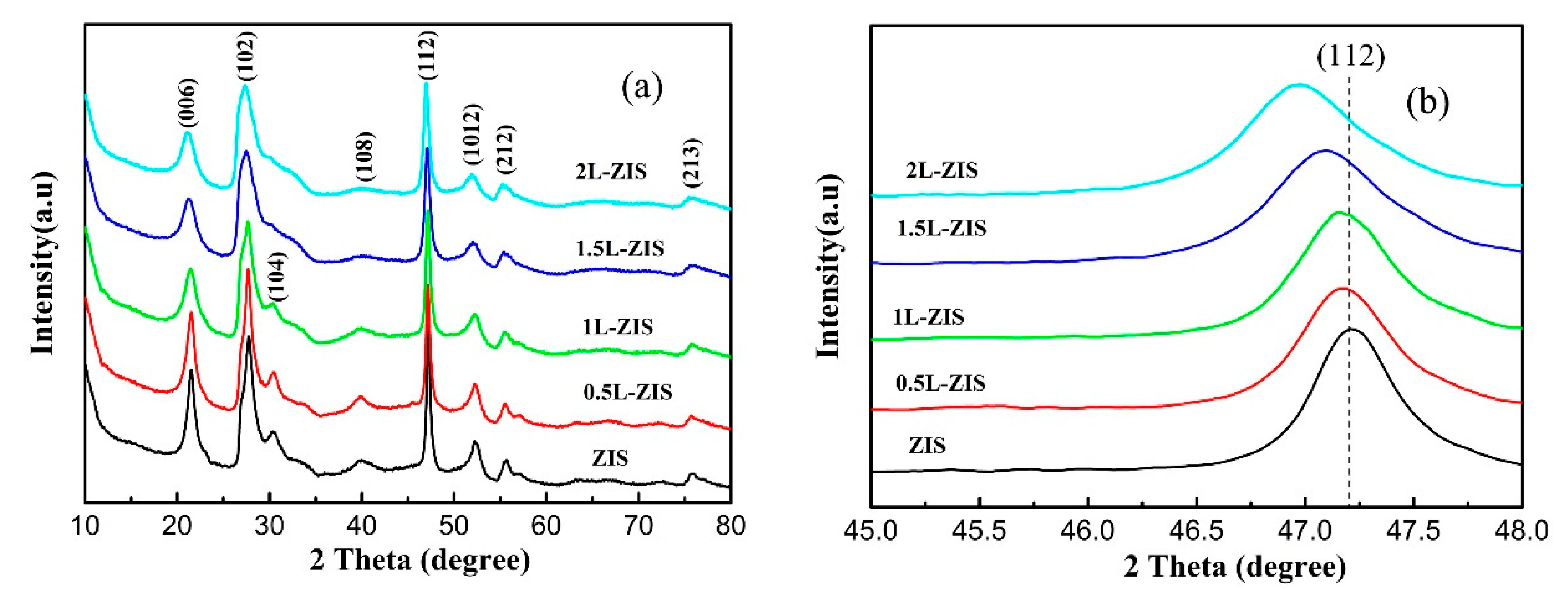
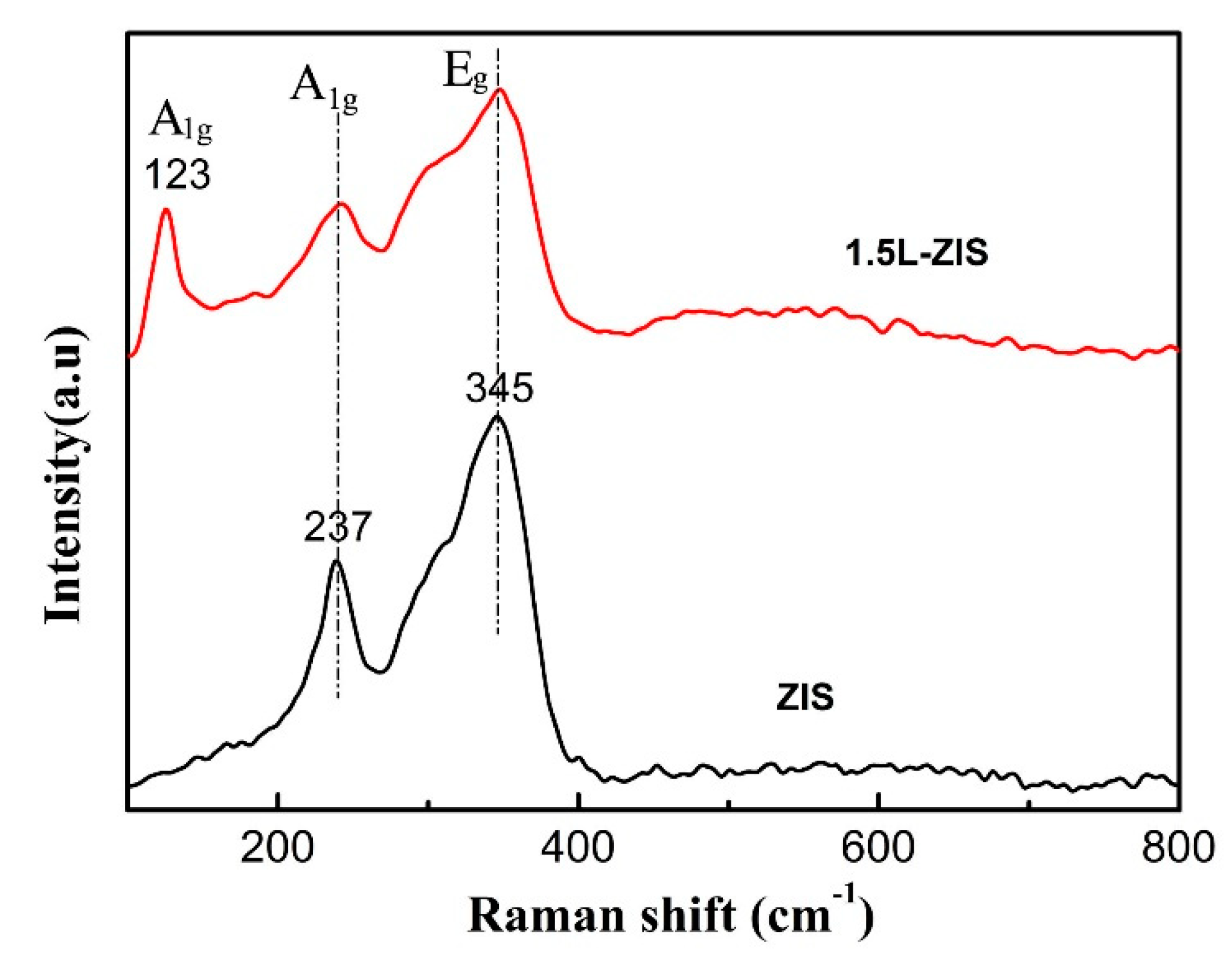

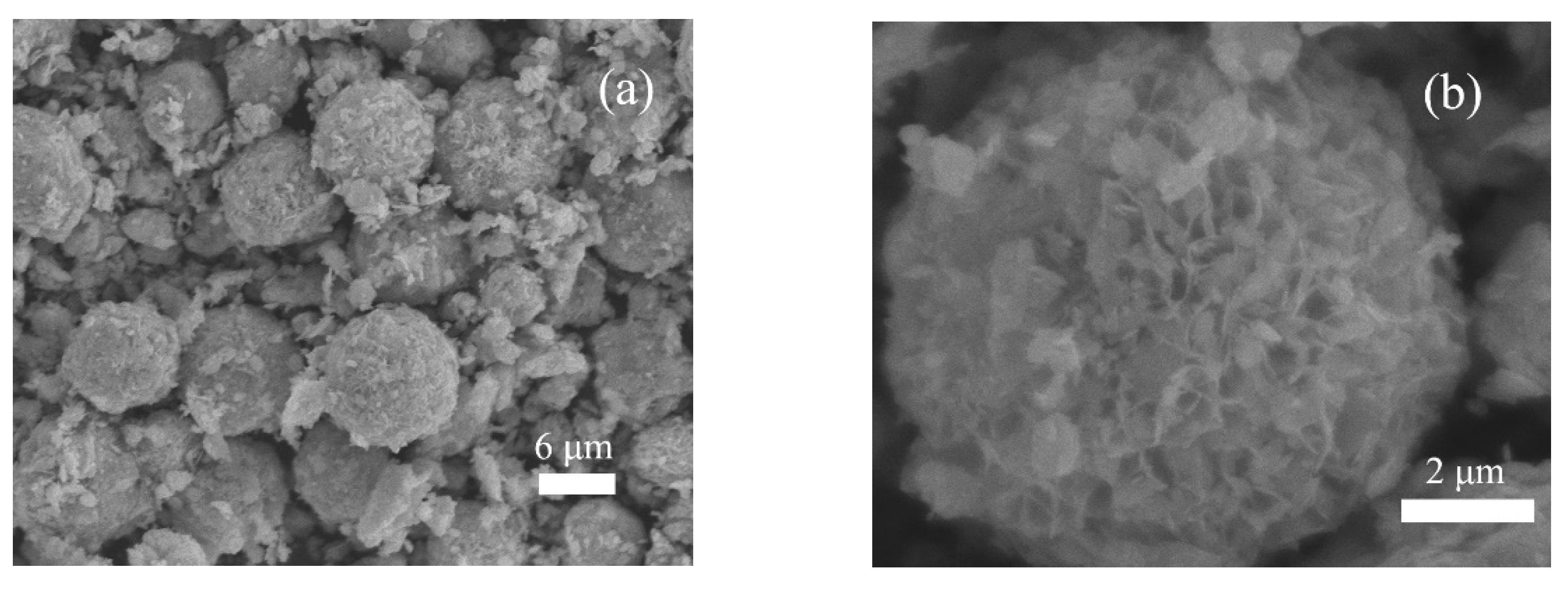


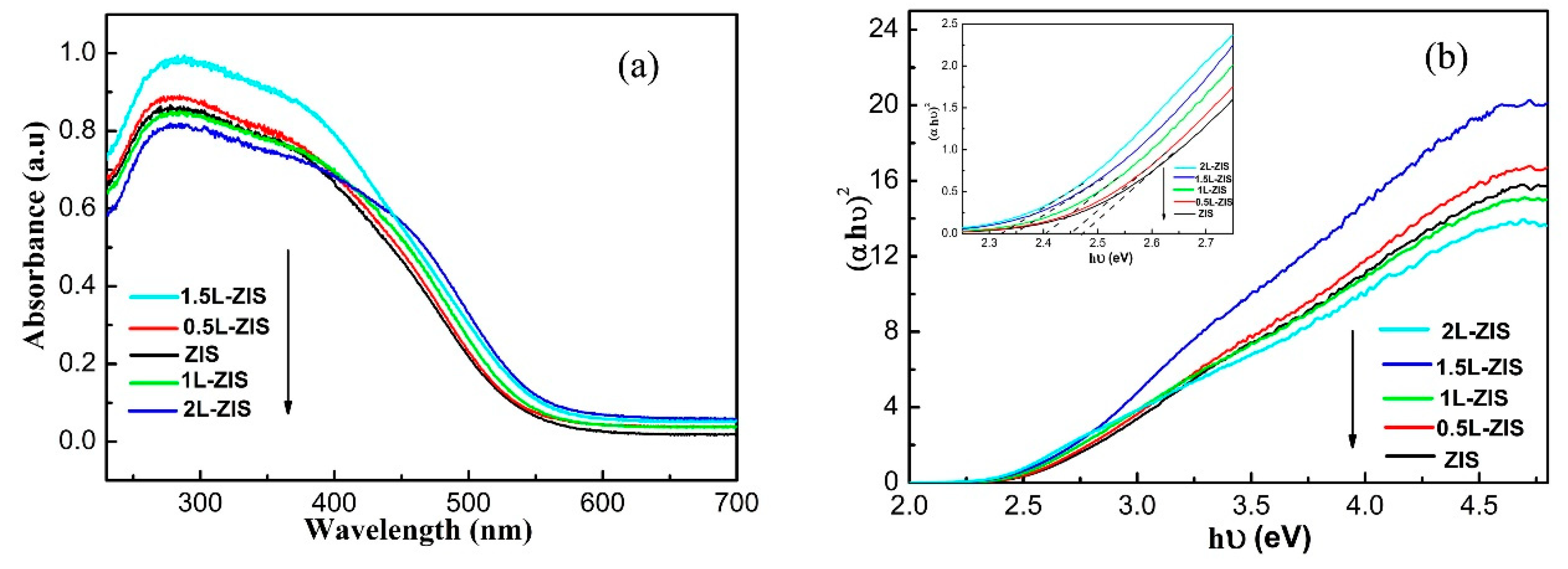
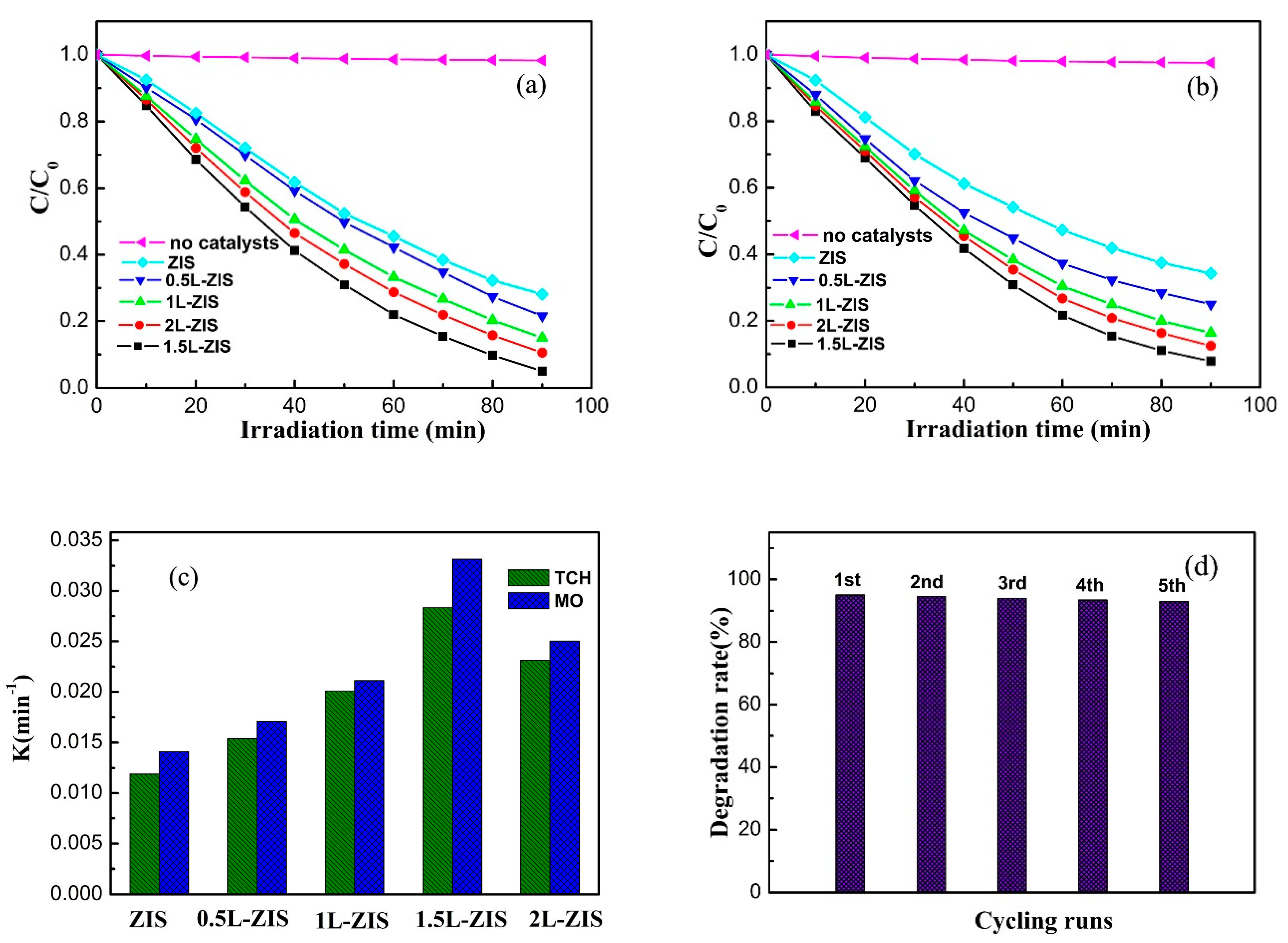
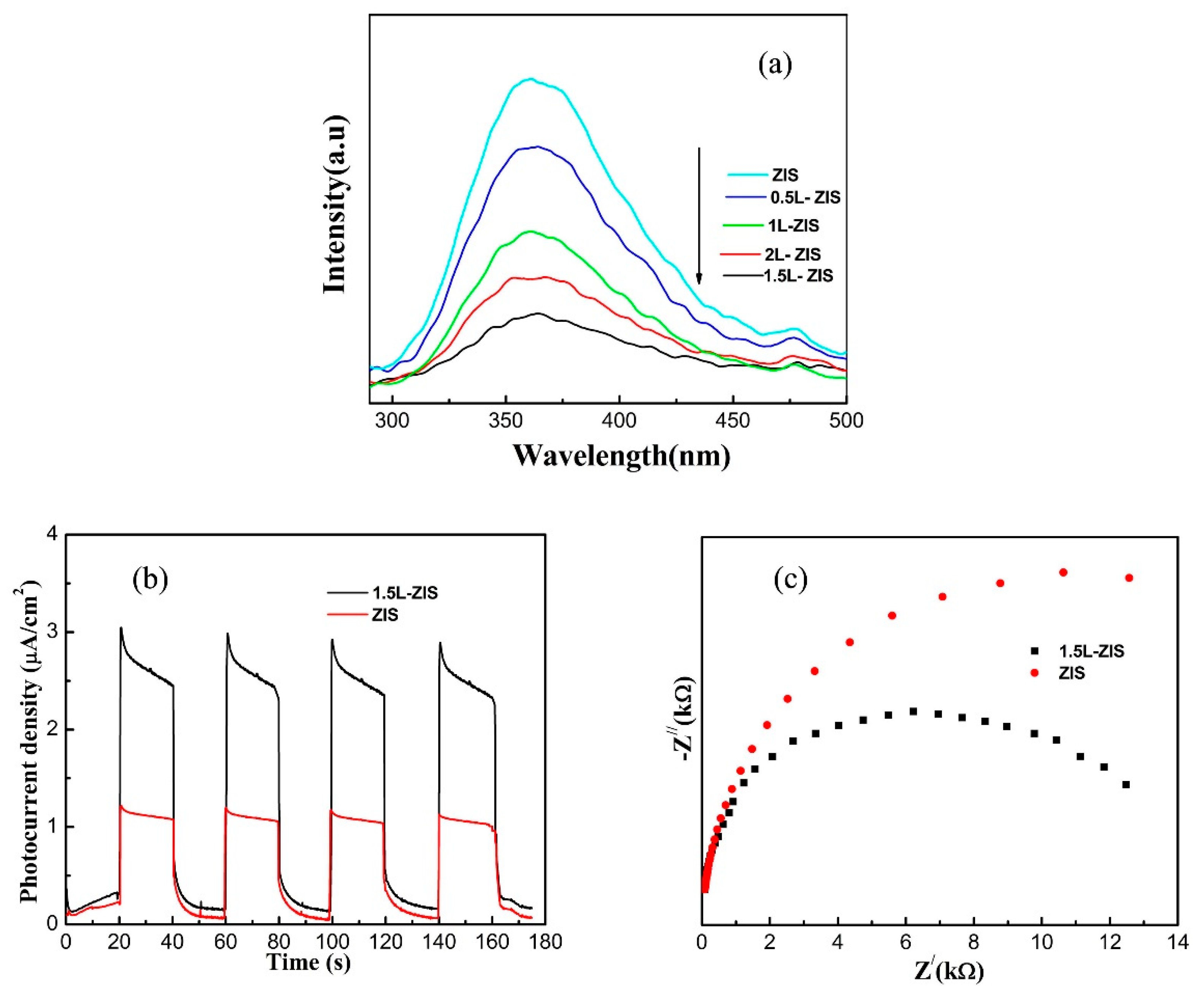
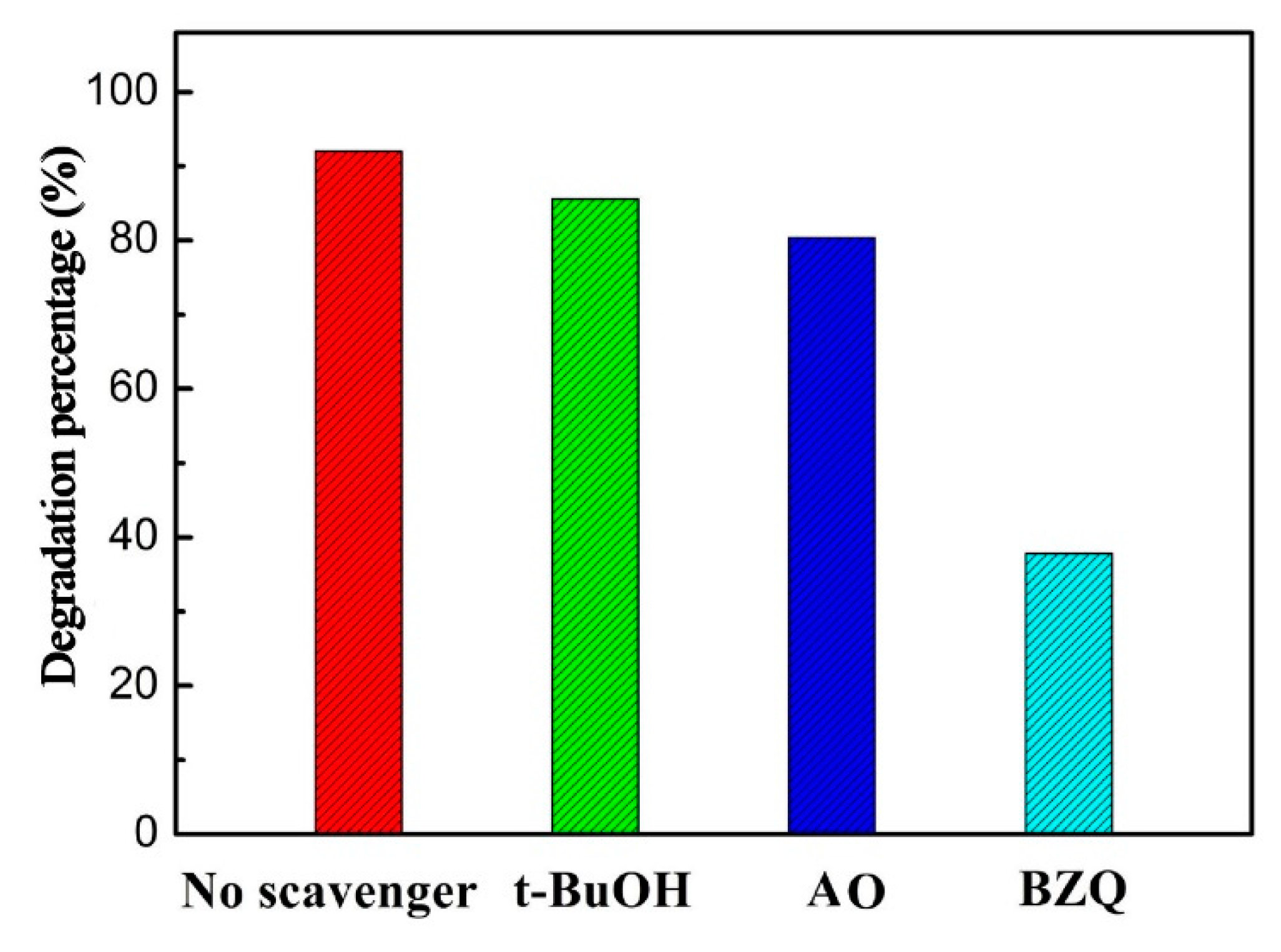
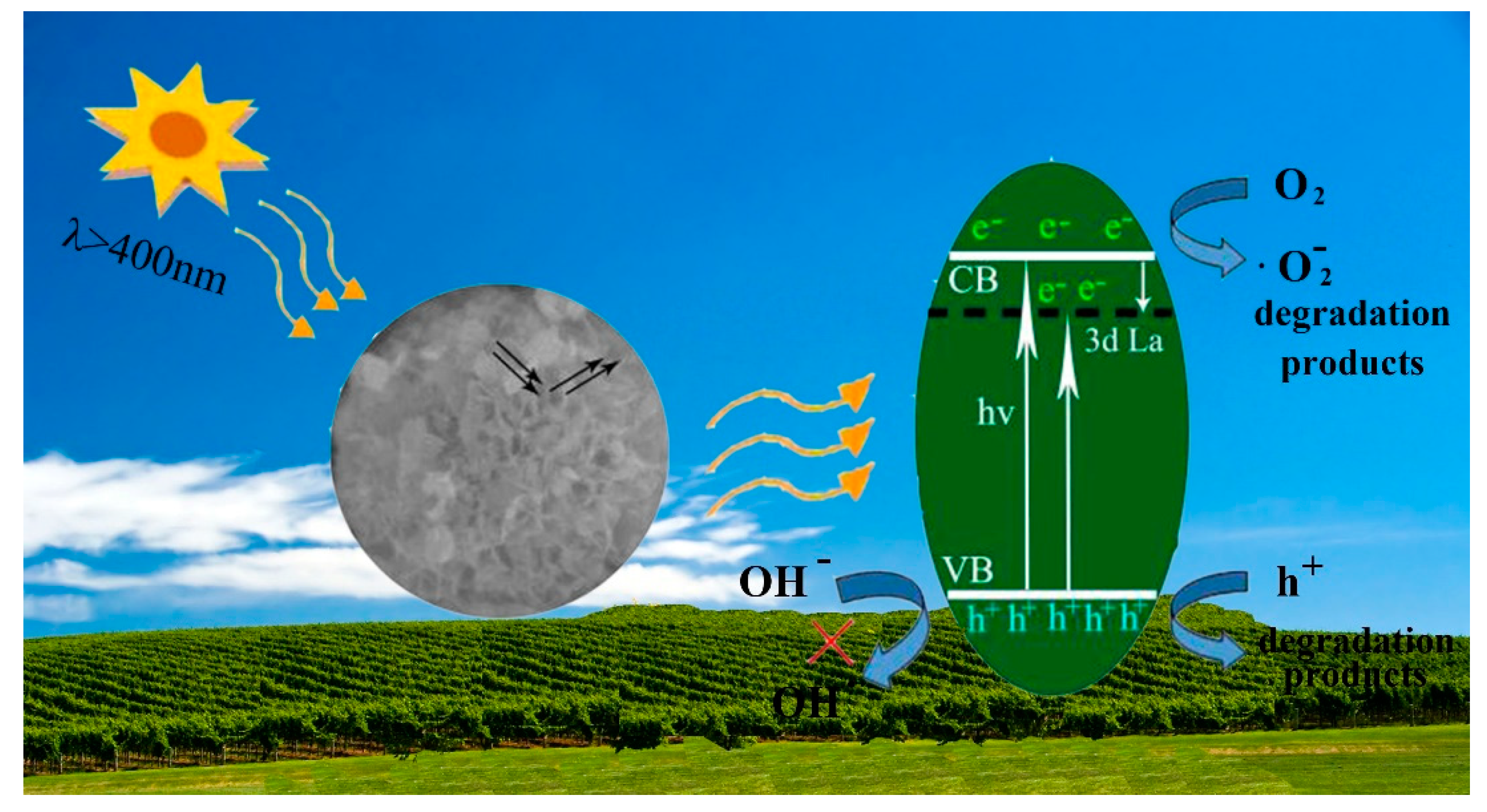
Publisher’s Note: MDPI stays neutral with regard to jurisdictional claims in published maps and institutional affiliations. |
© 2020 by the authors. Licensee MDPI, Basel, Switzerland. This article is an open access article distributed under the terms and conditions of the Creative Commons Attribution (CC BY) license (http://creativecommons.org/licenses/by/4.0/).
Share and Cite
Jia, T.; Liu, M.; Zheng, C.; Long, F.; Min, Z.; Fu, F.; Yu, D.; Li, J.; Lee, J.H.; Kim, N.H. One-Pot Hydrothermal Synthesis of La-Doped ZnIn2S4 Microspheres with Improved Visible-Light Photocatalytic Performance. Nanomaterials 2020, 10, 2026. https://doi.org/10.3390/nano10102026
Jia T, Liu M, Zheng C, Long F, Min Z, Fu F, Yu D, Li J, Lee JH, Kim NH. One-Pot Hydrothermal Synthesis of La-Doped ZnIn2S4 Microspheres with Improved Visible-Light Photocatalytic Performance. Nanomaterials. 2020; 10(10):2026. https://doi.org/10.3390/nano10102026
Chicago/Turabian StyleJia, Tiekun, Ming Liu, Chunyang Zheng, Fei Long, Zhiyu Min, Fang Fu, Dongsheng Yu, Jili Li, Joong Hee Lee, and Nam Hoon Kim. 2020. "One-Pot Hydrothermal Synthesis of La-Doped ZnIn2S4 Microspheres with Improved Visible-Light Photocatalytic Performance" Nanomaterials 10, no. 10: 2026. https://doi.org/10.3390/nano10102026
APA StyleJia, T., Liu, M., Zheng, C., Long, F., Min, Z., Fu, F., Yu, D., Li, J., Lee, J. H., & Kim, N. H. (2020). One-Pot Hydrothermal Synthesis of La-Doped ZnIn2S4 Microspheres with Improved Visible-Light Photocatalytic Performance. Nanomaterials, 10(10), 2026. https://doi.org/10.3390/nano10102026





